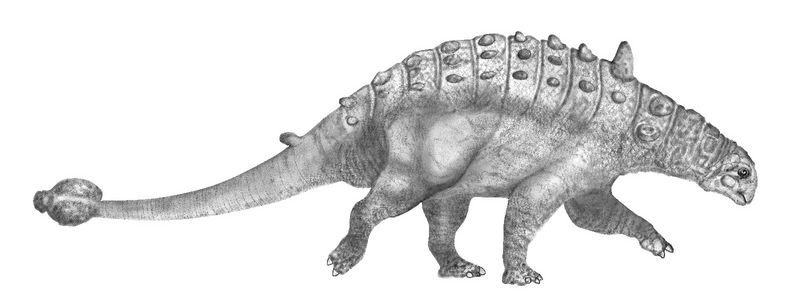Euoplocephalus - Wiki Euoplocephalus
From Wikipedia, the free encyclopedia
[Photo] Euoplocephalus. Date 26 septembre 2004. Author Luna04 http://fr.wikipedia.org/wiki/User:Luna04
Euoplocephalus (yu-op-lo-SEF-ah-lus) meaning 'well-armored head' (Greek eu-/ευ- meaning 'well', hoplo-/οπλο- meaning 'armed' and kephale/κεφαλη meaning 'head') was one of the largest of the ankylosaurian dinosaurs, at about the size of a small elephant. It is also the ankylosaurian with the best fossil record, so its stiff shell of spiked armor, low-slung body, and great club-like tail are well documented. It is also known as Scolosaurus.
Description
Among the ankylosaurids, Euoplocephalus was exceeded in size only by Tarchia and Ankylosaurus. Euoplocephalus was 6 meters (20 ft) long and weighed about 2 metric tonnes (2.2 tons). While it was 2.4 meters (8 feet) wide, it was low-slung, with short, stout legs. The rear legs were larger than the front legs and all four limbs were tipped with hoof-like claws. A trackway of an ankylosaur, found in 1996, at Sucre, Bolivia, indicates that Euoplocephalus could probably have moved with moderate speed.
Like all ankylosaurids, it had a flat, thick, triangular skull, with little capacity for a brain. The mouth was a horny beak and the teeth were small, weak and peg-like. It had a short neck.
Armed and armored
The entire head and body of the Euoplocephalus are covered with bands of armor, which allowed a surprising amount of flexibility. It was the first ankylosaurid discovered with armored shutters that it could slide down to cover its eyelids.
Each narrow band of armor was composed of a thick oval plate, embedded in the thick surrounding skin, which was studded with short, horny spikes (dermal scutes, like those of crocodiles), which were about 10 to 15 centimeters (4 to 6 inches) long. In addition to the spines running down its back, Euoplocephalus had large horns growing from the back of its head.
It also had a bony club at the end of its rigid tail, which it carried in a raised position. The tail was muscular, so the club could be swung from side to side for defense.
Internally, many bones were fused together to provide support for the heavy armor. The backbone (the dorsal vertebrae) is merged with the ribs, and several of the backbones in front of the hips (presacral vertebrae) were also fused together into a rod. The tail is made from hardened tissues, which are fused to the tail bones (known as caudal vertebrae).
Environment
Euoplocephalus lived between 85 and 65 million years ago, in the Campanian- Maastrichtian age of the late Cretaceous period.
Euoplocephalus was a plant eating (herbivorous) dinosaur. It had a complicated nose design (nasal structure), which indicates that it probably had a good sense of smell. It had flexible legs, which it might have used for digging. The stiff, low-slung dinosaur had poor teeth (weak dentition), so it must have grazed on fleshy low-lying vegetation and shallow tubers.
As all the skeletons discovered have been isolated, the conventional wisdom is that all ankylosaurids were solitary. However the discovery of a herd of 22 young Pinacosaurus was announced in 1988, which indicates that Euoplocephalus may have displayed herd behavior, at least as a juvenile.
Only the underbelly of the Euoplocephalus was unarmored. Like a porcupine, flipping it over may have been the only way to harm it. A survey of dinosaur bones in Alberta, Canada supports this, showing many bite marks on dinosaurs like the unarmored Hadrosaurus, but none on the ankylosaurids. There is some speculation, however, that the incredible biting power of the Tyrannosaurus may have ultimately led to the species' extinction. Preying on Euoplocephalus may have been risky for the attacker, because a swing of the tail could have caused massive damage, had it hit the predator in the stomach or its legs.
Classification and history
Paleontologist Lawrence Morris Lambe discovered the first specimen (the holotype) 1902 and proposed the name Stereocephalus. However, the name was already assigned to an insect (the name was preoccupied), so he changed it to Euoplocephalus in 1910. This new name has been misspelled in more than a dozen different ways, in formal scientific literature. It was also once thought to be the same genus as Ankylosaurus.
The original species is now known as Euoplocephalus tutus, and a second species, Euoplocephalus acutosquameus (originally named Dyoplosaurus), was discovered by William Arthur Parks in 1924. While the two species have clubs with different shapes, they may actually be the same species. Specimens now assigned to the Tarchia and Ankylosaurus genera were also considered to be species of Euoplocephalus at one point.
Fossils from more than 40 individuals have been discovered in Alberta, Canada and Montana in the United States, making Euoplocephalus the best known ankylosaurid. This includes 15 skulls, teeth and one almost-complete skeleton, found with the armor still attached. The tail club is particularly common.
Cladogram
A simplified version of one possible evolutionary tree (a cladogram):
Ornithischia ("bird hipped" dinosaurs)
Thyreophora (the armored "shield bearers")
Ankylosauria (the tanks)
Nodosauridae (early ankylosaurians)
Ankylosauridae
Polacanthinae (like Gastonia)
Shamosaurinae (like Shamosaurus)
Ankylosaurinae (like Ankylosaurus and Tarchia)
Euoplocephalus
http://en.wikipedia.org/wiki/Euoplocephalus
| The text in this page is based on the copyrighted Wikipedia article shown in above URL. It is used under the GNU Free Documentation License. You may redistribute it, verbatim or modified, providing that you comply with the terms of the GFDL. |
